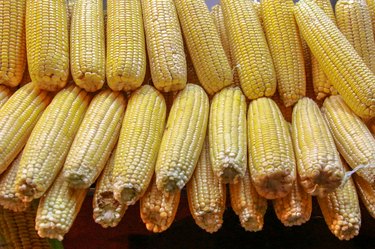
There's so much information about carbohydrates and how they affect your body that you might wonder how they're all related to one another and where they come from. Glucose, a kind of sugar, can come from many places, but one common source of industrial glucose is corn starch, which comes from a specific part of the corn kernel.
Corn Starch
Video of the Day
Corn kernels, like kernels of other grains, have many parts. They're surrounded by a tough outer coating that is high in fiber and protects the delicate contents inside. They also have a protein-rich germ, or portion of the corn that will sprout into a new plant. This is surrounded by a carbohydrate-rich mass called the endosperm. Corn starch comes from this endosperm. It consists of molecules of amylose, commonly called starch, explain Drs. Reginald Garrett and Charles Grisham in their book "Biochemistry." Because of the source, the amylose from corn is called corn starch, but it's chemically identical to starch from other plants.
Video of the Day
Glucose
Glucose is a kind of sugar. Specifically, it's a monosaccharide, which means that it's a sugar in its own right but is also a building block of larger sugars and other carbohydrates, including fiber and starch. In fact, amylose is nothing more than long chains of glucose molecules chemically bonded to one another, explain Drs. Mary Campbell and Shawn Farrell in their book "Biochemistry." There's also glucose in table sugar, and glucose exists on its own in sources like fruit.
Making Glucose
Glucose is a common sweetening agent in manufactured foods, though it's not as common in homemade items, which tend to use the glucose-containing table sugar, or sucrose, instead. While it's possible to extract glucose from fruit and other sources, it's cheapest to obtain glucose from corn starch. The starch is treated with enzymes called amylases that break the amylose chains into their constituent glucose molecules, which taste much sweeter than the original starch.
Health
Even though corn starch tastes starchy and glucose tastes sweet, a spoonful of corn starch is really chemically equivalent to a spoonful of glucose, at least as far as your body sees it. When you consume starch, your digestive enzymes immediately break it down into its constituent glucose. Within minutes of swallowing corn starch, it's already being converted into pure glucose in your digestive tract, making the two less different than you might think.
Is this an emergency? If you are experiencing serious medical symptoms, please see the National Library of Medicine’s list of signs you need emergency medical attention or call 911.